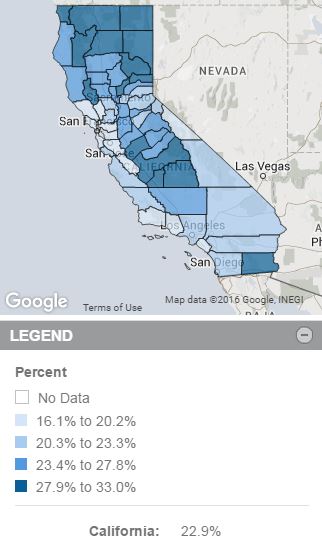Highest Concentration of Child Hunger in CA Shifts to Northernmost Counties
School is out, which means that child hunger is more visible as millions of low-income California children will no longer have easy access to nutritious school-provided meals. To better understand the demand for food assistance programs, Kidsdata has made available the latest food insecurity data, which show that 23 percent of California children, higher than the national average of 21 percent, lived in a food insecure household in 2014.
The geographic disparities are startling. Data show that California’s seven northernmost counties have some of the greatest need. In those counties, 26 to 32 percent of children lived in food insecure households in 2014. Just three years earlier, in 2011, the counties with the highest percentages were primarily located in the Central Valley. On the other end of the spectrum, the San Francisco Bay Area had the lowest percentages in the state, both in 2011 and 2014. In 2014, the nine Bay Area counties were home to 16 to 22 percent of children living in food insecure households.
Public food assistance programs such as the Free or Reduced Price School Meal program, Summer Food Service Program, and CalFresh provide a safety net to help ensure that low-income children get adequate nutrition to improve their physical health, behavior, school performance, and cognitive development.
Many children who are eligible for these programs do not use them. In California public schools, one-third (PDF) of the state’s low-income students miss out on free or reduced price school lunch during the school year, and two-thirds miss out on school breakfast. The numbers drop even more during the summer months. In California, less than 20 percent (PDF) of children in need access the Summer Food Service Program.
According to experts, policies and programs that could improve nutrition assistance participation, and the quality of the meals themselves, include simplifying and de-stigmatizing access to free and reduced price school meals, adopting more effective breakfast service models, and ensuring the availability of nutritious, appealing school meals and snacks without competition from unhealthy foods.
Related Data:
Helpful Links
California Food Policy Advocates
Feeding America
USDA Food and Nutrition Service: School Meals
Hunger Doesn't Take a Vacation: Summer Nutrition Status Report (PDF), Food Research and Action Center
Promoting Food Security for All Children, American Academy of Pediatrics
The CalFresh Food Assistance Program, Public Policy Institute of California
Kidsdata Tip
Looking for data by demographic? Kidsdata has data broken down by Age, Gender, Race/Ethnicity and more.
|
Children Living in Food Insecure Households
Year: 2014

|

